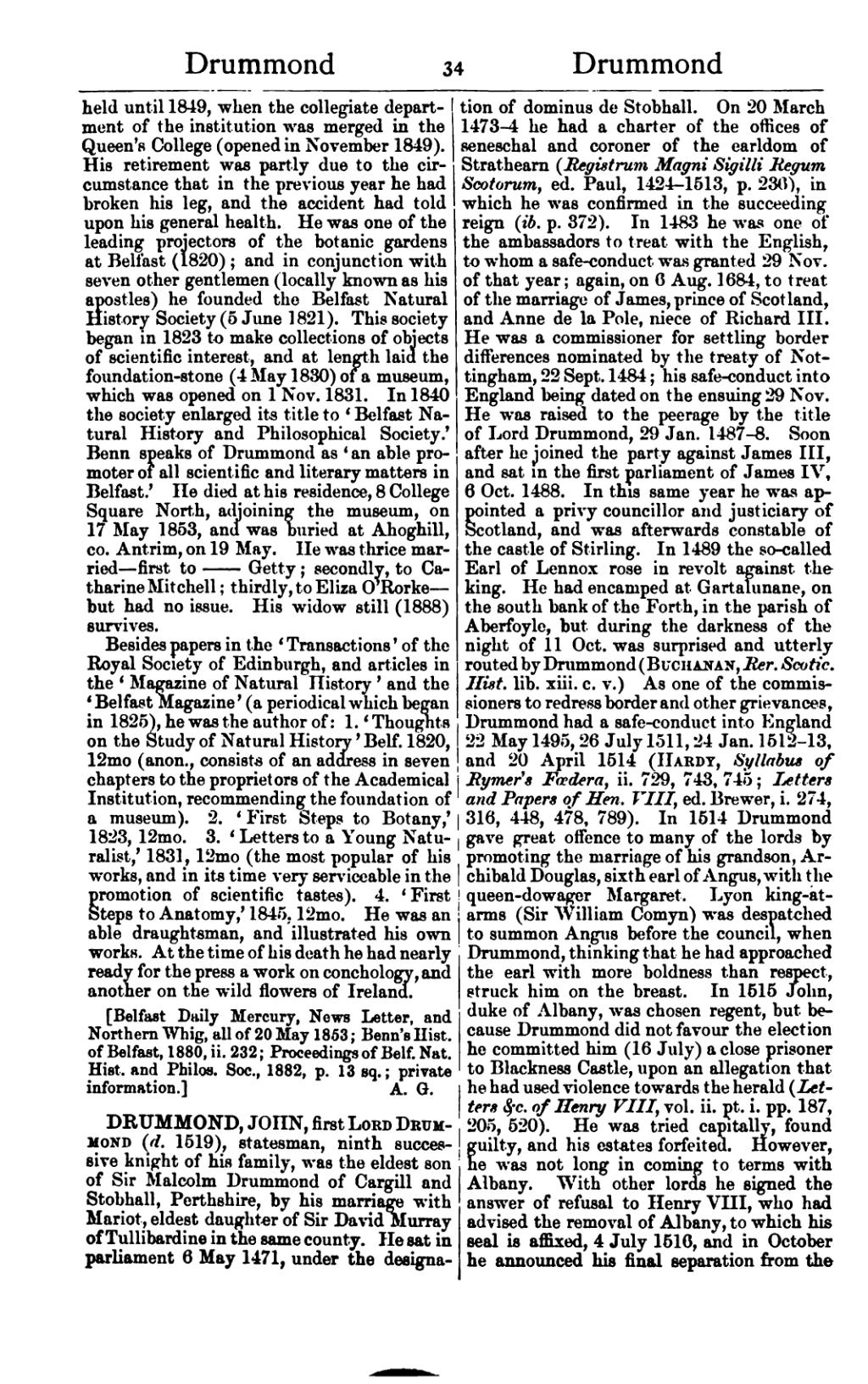held until 1849, when the collegiate department of the institution was merged in the Queen's College (opened in November 1849). His retirement was partly due to the circumstance that in the previous year he had broken his leg, and the accident had told upon his general health. He was one of the leading projectors of the botanic gardens at Belfast (1820); and in conjunction with seven other gentlemen (locally known as his apostles) he founded the Belfast Natural History Society (5 June 1821). This society began in 1823 to make collections of objects of scientific interest, and at length laid the foundation-stone (4 May 1830) of a museum, which was opened on 1 Nov. 1831. In 1840 the society enlarged its title to ‘Belfast Natural History and Philosophical Society.’ Benn speaks of Drummond as ‘an able promoter of all scientific and literary matters in Belfast.’ He died at his residence, 8 College Square North, adjoining the museum, on 17 May 1853, and was buried at Ahoghill, co. Antrim, on 19 May. He was thrice married—first to a lady named Getty; secondly to Catharine Mitchell; thirdly, to Eliza O'Rorke—but had no issue. His widow still (1888) lives.
Besides papers in the ‘Transactions’ of the Royal Society of Edinburgh, and articles in the ‘Magazine of Natural History’ and the ‘Belfast Magazine’ (a periodical which began in 1825), he was the author of: 1. ‘Thoughts on the Study of Natural History,’ Belf. 1820 12mo (anon., consists of an address in seven chapters to the proprietors of the Academical Institution, recommending the foundation of a museum). 2. ‘First Steps to Botany,’ 1823, 12mo. 3. ‘Letters to a Young Naturalist,’ 1831, 12mo (the most popular of his works, and in its time very serviceable in the promotion of scientific tastes). 4. ‘First Steps to Anatomy,’ 1845, 12mo. He was an able draughtsman, and illustrated his own works. At the time of his death he had nearly ready for the press a work on conchology, and another on the wild flowers of Ireland.
[Belfast Daily Mercury, News Letter, and Northern Whig, all of 20 May 1853; Benn's Hist. of Belfast, 1880, ii. 232; Proceedings of Belf. Nat. Hist. and Philos. Soc., 1882, p. 13 sq.; private information.]
DRUMMOND, JOHN, first Lord Drummond (d. 1519), statesman, ninth successive knight of his family, was the eldest son of Sir Malcolm Drummond of Cargill and Stobhall, Perthshire, by his marriage with Mariot, eldest daughter of Sir David Murray of Tullibardine in the same county. He sat in parliament 6 May 1471, under the designation of dominus de Stobhall. On 20 March 1473–4 he had a charter of the offices of seneschal and coroner of the earldom of Strathearn (Registrum Magni Sigilli Regum Scotorum, ed. Paul, 1424–1513, p. 236), in which he was confirmed in the succeeding reign (ib. p. 372). In 1483 he was one of the ambassadors to treat with the English, to whom a safe-conduct was granted 29 Nov. of that year; again, on 6 Aug. 1484, to treat of the marriage of James, prince of Scotland, and Anne de la Pole, niece of Richard III. He was a commissioner for settling border differences nominated by the treaty of Nottingham, 22 Sept. 1484; his safe-conduct into England being dated on the ensuing 29 Nov. He was raised to the peerage by the title of Lord Drummond, 29 Jan. 1487–8. Soon after he joined the party against James III, and sat in the first parliament of James IV, 6 Oct. 1488. In this same year he was appointed a privy councillor and justiciary of Scotland, and was afterwards constable of the castle of Stirling. In 1489 the so-called Earl of Lennox rose in revolt against the king. He had encamped at Gartalunane, on the south bank of the Forth, in the parish of Aberfoyle, but during the darkness of the night of 11 Oct. was surprised and utterly routed by Drummond (Buchanan, Rer. Scotic. Hist. lib. xiii. c. v.). As one of the commissioners to redress border and other grievances, Drummond had a safe-conduct into England 22 May 1495, 26 July 1511, 24 Jan. 1512–13, and 20 April 1514 (Hardy, Syllabus of Rymer's Fœdera, ii. 729, 743, 745; Letters and Papers of Hen. VIII, ed. Brewer, i. 274, 316, 448, 478, 789). In 1514 Drummond gave great offence to many of the lords by promoting the marriage of his grandson, Archibald Douglas, sixth earl of Angus, with the queen-dowager Margaret. Lyon king-at-arms (Sir William Comyn) was despatched to summon Angus before the council, when Drummond, thinking that he had approached the earl with more boldness than respect, struck him on the breast. In 1515 John, duke of Albany, was chosen regent, but because Drummond did not favour the election he committed him (16 July) a close prisoner to Blackness Castle, upon an allegation that he had used violence towards the herald (Letters &c. of Henry VIII, vol. ii. pt. i. pp. 187, 205, 520). He was tried capitally, found guilty, and his estates forfeited. However, he was not long in coming to terms with Albany. With other lords he signed the answer of refusal to Henry VIII, who had advised the removal of Albany, to which his seal is affixed, 4 July 1516, and in October he announced his final separation from the
